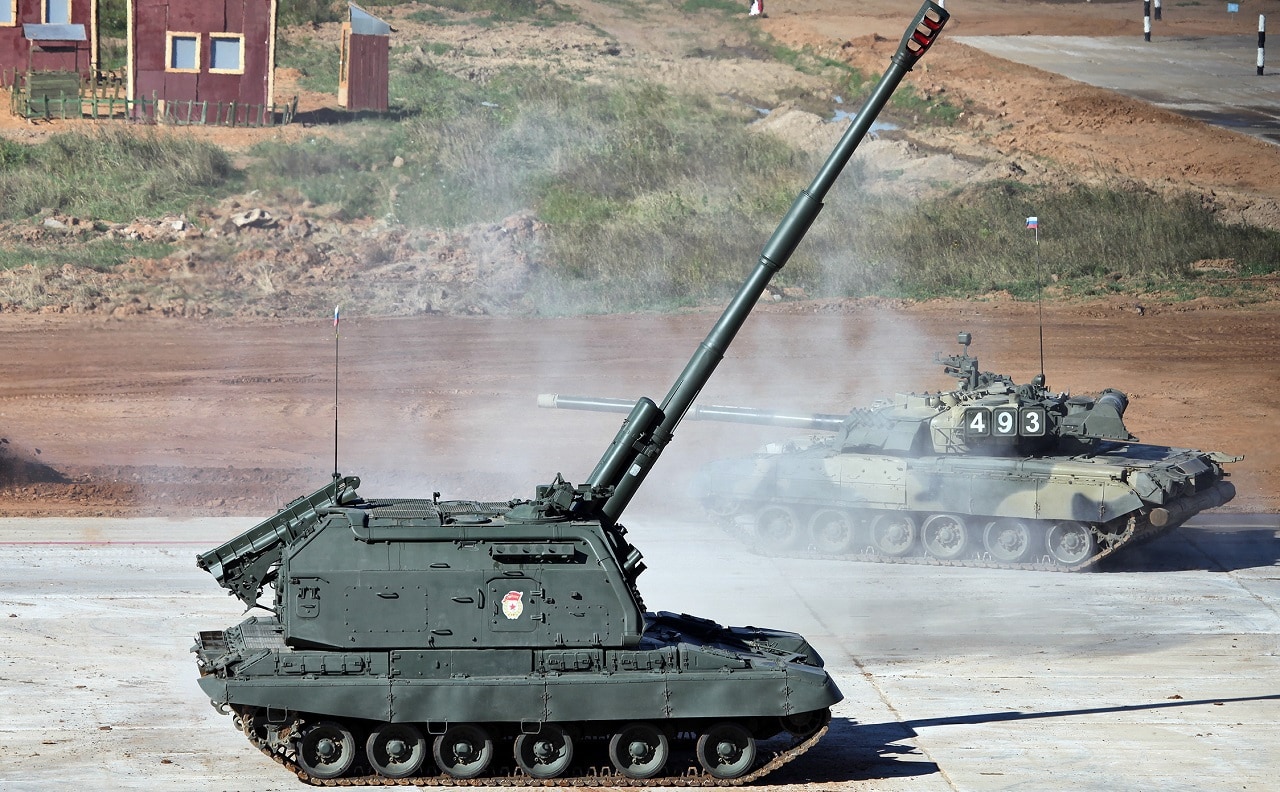Msta-S – The Russian Artillery Piece Like No Other – The Russians appear to have a distinct advantage in field artillery over the Ukrainians. They have hundreds of artillery pieces embedded within their battalion tactical groups. The Ukrainians should be commended for knocking out these pieces in numbers. Before the war the Russians were equipped with nearly 6,000 artillery pieces in their Army, so Vladimir Putin’s forces still have the means to bombard Ukrainian military targets and civilian population centers. Their military doctrine is to blast the enemy until Russia has a psychological advantage and the opposing force is demoralized.
Watch Out for Self-Propelled Howitzers
One artillery system that is the king of battle is the 2S19 Msta-S self-propelled howitzer. People often get these howitzers mixed up with tanks because they are tracked vehicles, but what sets apart a self-propelled howitzer is its long-tubed gun. Many observers on social media have attempted to track the Msta. Videos and descriptions of the artillery system in action have been spreading around the Internet since the beginning of the war.
The Msta-S Is a Major Part of Russian Military Doctrine
The Msta-S has also been spotted on trains and in columns of armored vehicles, plus in fixed positions around cities in several locations in Ukraine. This artillery piece is supposed to blast holes in enemy lines and allow the armor and infantry to stream through gaps.
So far, the Russians have struggled with this tactic. For Russians to follow their artillery doctrine, much depends on the Russian’s ability to re-supply their guns with support vehicles hauling shells and fuel. The Ukrainians have been adept at attacking these logistics trucks and the Msta itself has been destroyed in numbers – likely by Ukrainian tanks and counter-battery fire.
It’s a Big Gun
At 42-tons, the Msta-S is massive and is mounted on a T-80 main battle tank platform with a five-man crew. The Russian army had around 470 of these pieces with 270 in reserve before the invasion. The system entered service in 1989.
Strong Rate of Fire and Many Different Types of Munitions
It shoots 152mm rounds that can be auto-loaded enabling a firing rate of 7 to 8 shells per minute. The Msta-S can store up to 50-rounds. It fires high-explosive fragmentary shells mainly, but it also can send rounds with cluster-submunitions downrange, plus launch laser-guided shells. The cluster bomblets were designed to destroy tanks, but these shells are incredibly damaging against civilian targets and people in cities. One of its rounds can be equipped with radio jammers to foul up enemy communications.
The artillery piece can move and then stop and fire within one to two minutes. The Msta-S has a diesel engine similar to what is found on a T-72 tank that puts out 780 horsepower with a top speed of 37 miles per hour on roads.
The Msta-S Does Not Always Fire From the Rear
Typically, 18-tracked howitzers travel in a Russian battalion tactical group. Alternatively, the U.S. Army usually deploys artillery at the brigade-level. Howitzers in the battalion tactical groups often travel behind tanks and infantry fighting vehicles. This practice is a curse and a blessing. The commander of the battalion doesn’t have to call higher headquarters for fire missions (that’s the blessing), but since the artillery pieces are embedded directly they can be destroyed with enemy attacks on the traveling columns (that’s the curse).
These artillery units can also get out ahead of their supply chains, which the Ukrainians have taken advantage of by ambushing logistical vehicles. Another downside to the Msta is that its heavy size could risk being stuck in the mud as spring brings in warmer temperatures that thaw the ground.
Artillery is playing a large role in this war. The Russians are laying siege to the cities with artillery pieces and have them in such high numbers they can withstand considerable losses. The Msta-S can shoot rounds with cluster munitions, and these can take a heavy toll on civilians in dense population centers.
Now serving as 1945’s Defense and National Security Editor, Brent M. Eastwood, Ph.D., is the author of Humans, Machines, and Data: Future Trends in Warfare. He is an Emerging Threats expert and former U.S. Army Infantry officer. You can follow him on Twitter @BMEastwood.

